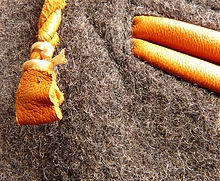Vadmal


Wadmal or Wadmal (altnordisch wadmal also walmal , vallman or valmar ) is a heavy fabric of wool , the fulled is, whereby the material durable, but especially windproof and water resistant.
The Swedish word Vadmal was originally Våd-mått , which means something like piece of cloth measure . The Icelandic name also indicates its use as a means of payment, because since “vað” belongs to a u̮ in “auðr” = wealth (the German “od” in gem), váð = tissue; “Mál” means measure. Vaðmál is the measured substance .
For centuries, woolen fabrics were the most important clothing fabric in Scandinavia , especially the hard and particularly heavy Vadmal made from the originally inferior Scandinavian wool (white wool was even better than black). Vadmal was widespread in the Scandinavian region until the 18th century. Vadmal is still used today by the Swedish army under the name Komisstyg . In addition, mostly older Scandinavian outdoor activists and hunters swear by the material, u. a., because it hardly makes any noise while stalking. Above all, however, the Sami people of Lapland traditionally use Vadmal to make their outerwear Kolt .
A royal decree in 1380 gave the peasants the right to trade in Vadmal. The substance served z. B. in Iceland as the main currency until the end of the 17th century, when it was superseded by knitwear . In Scandinavia, Vadmal was used as a measure of value in barter with the Sami in Lapland in the 15th century. It was used as a tent fabric for the feces and for the clothing of men and women, here for the bodice , jackets and skirts , in the colors white, gray, black and blue.
In some ancient Norwegian and Icelandic sources, Vadmal is described as an equilateral twill weave made on a weight loom in standardized length and width. However, the term was apparently sometimes also applied to coarse plain weave fabrics . Preserved samples of vadmal fabrics from Greenland and Iceland show a considerable difference between the warp and weft material . The warp threads usually had a strong twist , while the weft was softly spun . A piece from Denmark, on the other hand, has a much higher weft density than warp density.
literature
- Susan Larson-Fleming: Vadmal . In: Weaver's Journal X, 1986, pp. 26-29.
Individual evidence
- ↑ Wadmal . In: Heinrich August Pierer , Julius Löbe (Hrsg.): Universal Lexicon of the Present and the Past . 4th edition (1857-1865). Altenburg ( zeno.org ).
- ^ Gosta Bergman: etymologiska ordbok . Stockholm 1948
- ↑ Alexander Jóhannesson: Icelandic etymological dictionary . Bern 1956, p. 7 and 655. So also Jan de Vries: Old Norse etymological dictionary . Leiden 1977, p. 638.
- ↑ Anita Luvera Mayer: Handwoven clothing felted to wear . Shuttle Craft Books, Coupeville WA, ISBN 0-916658-45-7 , p. 18
- ↑ Anita Luvera Mayer: Handwoven clothing felted to wear . Shuttle Craft Books, Coupeville WA, ISBN 0-916658-45-7 , pp. 16-17
